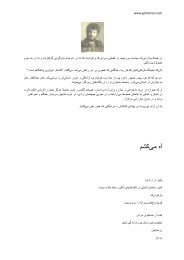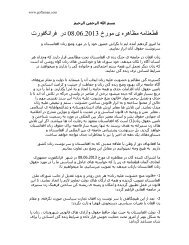Power-Sharing - Goftaman.com
Power-Sharing - Goftaman.com
Power-Sharing - Goftaman.com
- No tags were found...
You also want an ePaper? Increase the reach of your titles
YUMPU automatically turns print PDFs into web optimized ePapers that Google loves.
As shown in figure 3, U.S. pledges of assistance rose dramatically in 2004–2005,as Presidential Special Envoy and Ambassador Zalmay Khalilzad presided over aprogram called “Accelerate Success,” intended to build support for President Karzaiduring his election campaign. Figure 3 also shows, however, that the United States wasnot able to match disbursements to its pledges and <strong>com</strong>mitments. 28 Instead, the pressurefor politically motivated quick results led to waste and failure to deliver on Afghans’expectations. 29 Other donors have experienced similar problems, but they are particularlysevere for the United States. 30The Afghanistan Compact includes an annex on aid effectiveness. The Afghangovernment <strong>com</strong>mits itself to transparency and accountability, to raising more domesticresources, and to improving its capacity to manage expenditure and implement programs.In return, the donors agree to allocate their assistance according to ANDS priorities;provide “multiyear funding <strong>com</strong>mitments or indications of multiyear support”; increaseuntied aid channeled through the government budget; build Afghan capacity; and reporton aid in a way that enables the Afghan government to integrate aid into its nationalbudget and reports on its use to the National Assembly. 31More than 75 percent of all aid to Afghanistan funds projects directlyimplemented or contracted by donors. This mode of delivery, although initiallyinevitable, is ultimately self-defeating. If prolonged, it undermines, not builds, the state.Enabling the state to provide services directly promotes legitimacy and responsibility;integrating aid projects into the budgetary process promotes sustainability. A governmentthat cannot report to its parliament about public expenditure can hardly be calleddemocratic, no matter how many elections it holds.28 A pledge is a promise of an amount; a <strong>com</strong>mitment is a signed contract for a specific use of funds.Commitments lead to disbursements, which are deposits in to the accounts of trust funds or implementingagencies. Disbursed funds are turned into expenditures as projects are implemented, which can take yearsin some cases. Donors report on disbursement, which constitutes expenditure by the donor government, butnot on final expenditure on development, which is of greatest interest to the aid recipient.29 See Carlotta Gall and Somini Sengupta, “Afghan Electorate’s Message: The Provinces Need PublicWorks and Restoration of Order,” New York Times, September 20, 2005.30 Data from the Ministry of Finance for aid through the end of calendar year 2005 show that the UnitedStates had disbursed 36 percent of <strong>com</strong>mitments for that year, <strong>com</strong>pared to 58 percent for other donors.31 The World Bank–administered Afghanistan Reconstruction Trust Fund supports the government’srecurrent and development expenditures. Trust funds managed by the UNDP provide support for SSR andcounternarcotics.36
















